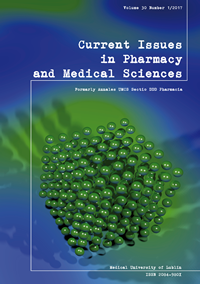Tlr2, Tjp1 genes expression during wound healing dynamics – with melanin treatment
DOI:
https://doi.org/10.1515/cipms-2017-0016Słowa kluczowe:
chemical burns, Tjp1, Tlr2 gene expression, melaninAbstrakt
Wound healing is the complex and dynamic process of replacing devitalized and missing cellular structures and tissue layers. We have previously shown that melanin, herein, produced by the Antarctic black yeast fungi Pseudonadsoniella brunea (Nadsoniella nigra sp. X-1), has expressed a cyto-protective effect, promoted rapid wound healing of various ethiology and can be offered as a new dermatropic drug. The current study was conducted on a rat model of purulent necrotic wound. In each model, one group was a control, while in the others, wound healing occurred without drug application or with administration of 0,5% carbopol or with both 0,5% carbopol and 0,1% melanin. The pro-oxidant-antioxidant balance in skin gomogenate in dynamics on 3, 6, 9, 14 and day of full epithelization was estimated using the spectrophotometric biochemical method. Moreover, so as to understand the role played by the Tlr2 and Tjp1 in the process of wound healing and scar formation, Tlr2, Tjp1 gene expression and genetic mRNA was determined with quantitative RT-PCR. The application of our pharmacological composition stimulated the decrease of Tlr2 and Tjp1 gene expression against the background of suppression of free radical processes (reduction of superoxide anion radical content) with epithelization and without scarring. The results of this study have shown the positive effects of melanin on wound healing. The obtained results indicate the advisability of applying melanin for the treatment of inflammatory processes.
Bibliografia
1. Able A.J., Guest D.I., Sutherland M.W.: Use of new tetrazolium-based assay to study the production of superoxide radicals by tobacco cell cultures challenged with avirulent zoospores of Phytophtora parasitica varnicotianae. Plant Physiol., 177, 491, 1998.
2. Bilyayeva O. et al.: Effects of Sea Silon wound healing in the rat. Journal of wound care, 23, 140, 2014.
3. Chomczynski P., Sacchi N.: Single-step method of RNA isolation by acid guanidiniumthiocyanate-phenol-chloroform extraction. Anal Biochem., 162, 156, 1987.
4. Cui Y. et al.: Chrysanthemum morifolium extract attenuates high-fat milk-induced fatty liver through peroxisome proliferator-activated receptor alpha-mediated mechanism in mice. Nutr Res., 34 ,268, 2014.
5. De Benedetto A. et al.: Tight junction defects in patients with atopic dermatitis. J Allergy Clin Immunol, 127, 773, 2011.
6. Dranitsina A.S. et al.: TGFB 1, PTGS 2 Genes Expression during Dynamics of Wound Healing and with the Treatment of Melanin. Research J Pharm Biol Chem Sci, 8, 2014, 2017.
7. Dvorshchenko К. et al.: Vpliv okisnogo stresu na riven ekspessii geniv TGF-β і HGF u pechinci schuriv v umovah trivaloi shlunkovoi hipohlorhidrii ta za vvedennya multiprobiotika Symbiter. Ukr Biochem J, 85, 114 Ukrainian, 2013.
8. Golyshkіn D.V. et al.: Effect of melanin on the condition of gastric mucosa and reaction of the hypothalamic-pituitary-adrenal axis under acute stress. Physiological journal, 61, 65. 2015.
9. Jin H et al.: Toll-like receptor 2 is important for the T(H)1 response to cutaneous sensitization. J Allergy Clin Immunol, 123, 875, 2009.
10. Kuo I-H. et al.: Activation of epidermal toll-like receptor 2 enhances tight junction function – Implications for atopic dermatitis and skin barrier repair. J Invest Dermatol, 133, 988, 2013.
11. Lee W.H. et al.: Irradiation induces regionally specific alterations in pro-inflammatory environments in rat brain. Int J Radiat Biol, 280, 132, 2010.
12. Nahid M.A., Satoh M., Chan E.K.: Mechanistic role of microRNA-146a in endotoxin-induced differential cross-regulation of TLR signaling. J Immunol., 186, 1723, 2011.
13. Penn J.W., Grobbelaar A.O., Rolfe K.J.: The role of the TGF-βfamily in wound healing, burns and scarring: a review. Int J Burn Trauma, 2, 18, 2012.
14. Qiao X., Roth I., Féraille E., Hasler U.: Different effects of ZO-1, ZO-2 and ZO-3 silencing on kidney collecting duct principal cellproliferation and adhesion. Cell Cycle, 13, 3059, 2014.
15. Sutherland M.W., Learmonth B.A.: The tetrazolium dyes MTS and XTT provide new quantitative assays for superoxide and superoxide dismutase. Free Radic. Res., 27, 283, 1997.
16. Taburets O.V. et al.: The Effect of «Melanin-Gel» on the Wound Healing. Res J Pharm Biol Chem Sci, 7, 2031, 2016.
17. Wagener F.A., Carels C.E., Lundvig D.M.: Targeting the redox balance in inflammatory skin conditions Int. J. Mol. Sci., 14, 9126, 2013.
Pobrania
Opublikowane
Numer
Dział
Licencja
Prawa autorskie (c) 2017 Autorzy

Praca jest udostępniana na licencji Creative Commons Attribution-NonCommercial-NoDerivatives 3.0 Unported License.


